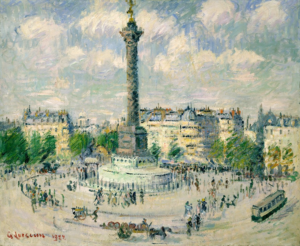 Since her arrival in the French capital in season one of this immediate Netflix hit, Emily has used her American influencer flair to successfully promote all manner of luxury products to the French market via her viral social media campaigns. And with all the usual drama along the way, she goes from strength to strength in season three.
Since her arrival in the French capital in season one of this immediate Netflix hit, Emily has used her American influencer flair to successfully promote all manner of luxury products to the French market via her viral social media campaigns. And with all the usual drama along the way, she goes from strength to strength in season three.
The show’s love affair with big-name brands makes it a product placement dream. But it is, of course, the city of Paris that is its most successful product by far.
The show is not set in the real Paris, the French metropolis of more than 2 million inhabitants, but a parallel “Paris™” – a perfect version. This is Paris the brand, one that has been carefully curated by generations of writers, artists and filmmakers over hundreds of years.
Paris in the global imagination
Paris is everybody’s favourite fantasy city.
There’s Emma Bovary’s imaginary wanderings around the city in Gustave Flaubert’s 1857 masterpiece, and Amélie Poulain’s playful treasure hunt in the eponymous 2001 blockbuster. The Impressionists painted dreamy scenes of outdoor cafes and sunsets on the Seine. And who could forget Juliette Binoche’s firework-illuminated antics in Leos Carax’s 1991 classic Les Amants du Pont-Neuf (The Lovers on the Bridge)?
As well as the City of Light, Paris has always been a city of dreams, romance and beauty in the global imagination.
Like its on-screen predecessors, Emily’s Paris is instantly recognisable as “Paris™”. But it is simultaneously unrecognisable, bearing very little resemblance to the real Paris you encounter when you step off the Eurostar at the Gare du Nord. Indeed, even the fleeting representation of this train station in Emily in Paris is unrealistic.
 When Emily goes to surprise her English love interest, Alfie, on his return from London in the middle of season three, she waits for him outside the station’s main entrance. But anyone who has arrived in Paris by Eurostar knows that travellers from London either vanish underground to the station’s many Métro lines, or turn right to head for the taxi rank at the side-exit. Either Alfie is walking or he is taking the bus – which, given these characters’ addiction to taxis, seems highly unlikely.
When Emily goes to surprise her English love interest, Alfie, on his return from London in the middle of season three, she waits for him outside the station’s main entrance. But anyone who has arrived in Paris by Eurostar knows that travellers from London either vanish underground to the station’s many Métro lines, or turn right to head for the taxi rank at the side-exit. Either Alfie is walking or he is taking the bus – which, given these characters’ addiction to taxis, seems highly unlikely.
In fact, Paris has an efficient, affordable and comprehensive public transport system. The city is served by 14 metro lines, 58 bus routes and three trams. Most Parisians (65%) travel to work by public transport And the numbers who travel to work on foot like Emily and her boss Sylvie (Philippine Leroy-Beaulieu) are much smaller (10%).
Despite the enduring cliche, only about 5% of Parisians cycle to worklike Emily’s colleague Luc (Bruno Gouery). Yet except for a couple of fleeting shots of the picturesque above-ground sections of Métro lines 6 and 2, Emily’s Paris is devoid of public transport. It is equally empty of cars.
Despite recent improvements in pedestrian access, especially along the Seine, Paris is still absolutely full of traffic. Taxis, cars, bikes, mopeds, electric scooters, emergency vehicles, dustbin lorries and rollerbladers all battle for space on its always congested roads. And yet Emily and her friends spend hours sitting in outdoor café terraces without ever being affected by noise or air pollution.
Where are all the Parisians?
Emily’s Paris is also eerily empty of people. And those who do walk its streets are almost all  young and attractive. This gives us dangerously unrealistic expectations of the city. “Paris Syndrome”, the shock experienced by tourists when Paris does not live up to expectations, is responsible for around 50 episodesof serious mental illness per year.
young and attractive. This gives us dangerously unrealistic expectations of the city. “Paris Syndrome”, the shock experienced by tourists when Paris does not live up to expectations, is responsible for around 50 episodesof serious mental illness per year.
Real Paris is a bustling metropolis whose pavements are always crowded with people of all ages, races and economic status. Like other European capitals, Paris has seen a huge increase in homelessness over the last several decades. Whole areas of the city near the ring road and under bridges have been transformed into makeshift refugee camps.
These harsh social and economic realities are airbrushed out of Emily’s Paris along with rubbish bins, police sirens and the building sites that always seem to proliferate in this city.
During filming for season three, the iconic Notre-Dame cathedral was shrouded in scaffolding following the devastating 2019 fire – yet the cathedral appears completely unscathed in several shots of the river.
Some comfort can be taken in the fact that the show’s characters are refreshingly aware they are living in a fictional Paris. They frequently acknowledge that life in Paris is a dream and compare their lives to a film with a Hollywood (rather than “French”) ending.
Season three even begins with a dream sequence which is repeated in real life later in the same episode. This blurring of dream and reality reminds us that Emily in Paris is a guilty pleasure, a marvel of escapism which is about as good at impersonating Paris as Emily is at speaking French. (The Conversation)
– Hannah J Thompson
Artwork: Gustave Loiseau, La Place de la Bastille, 1922



